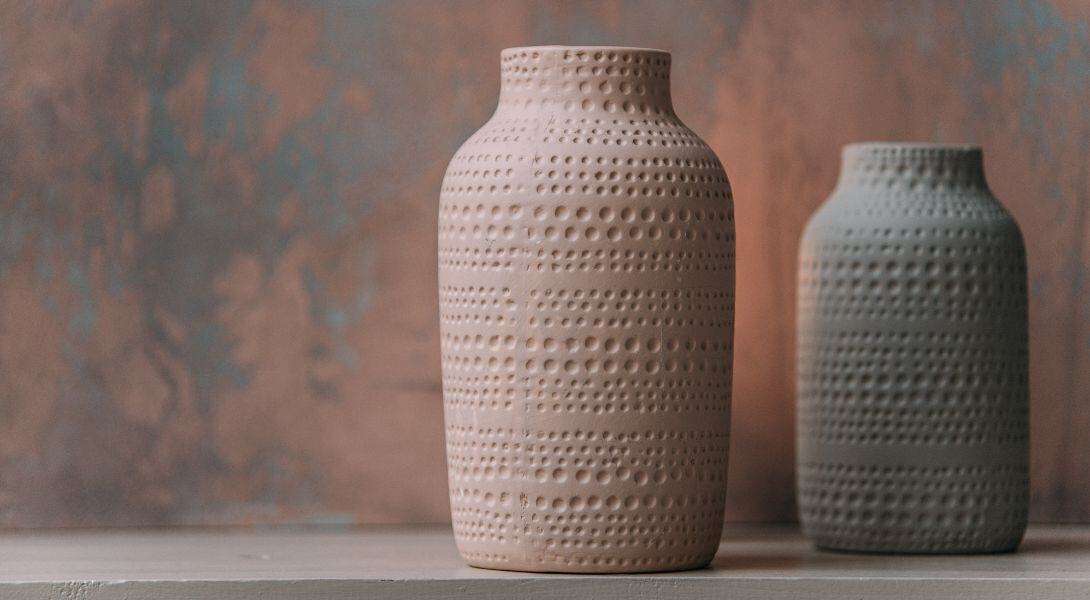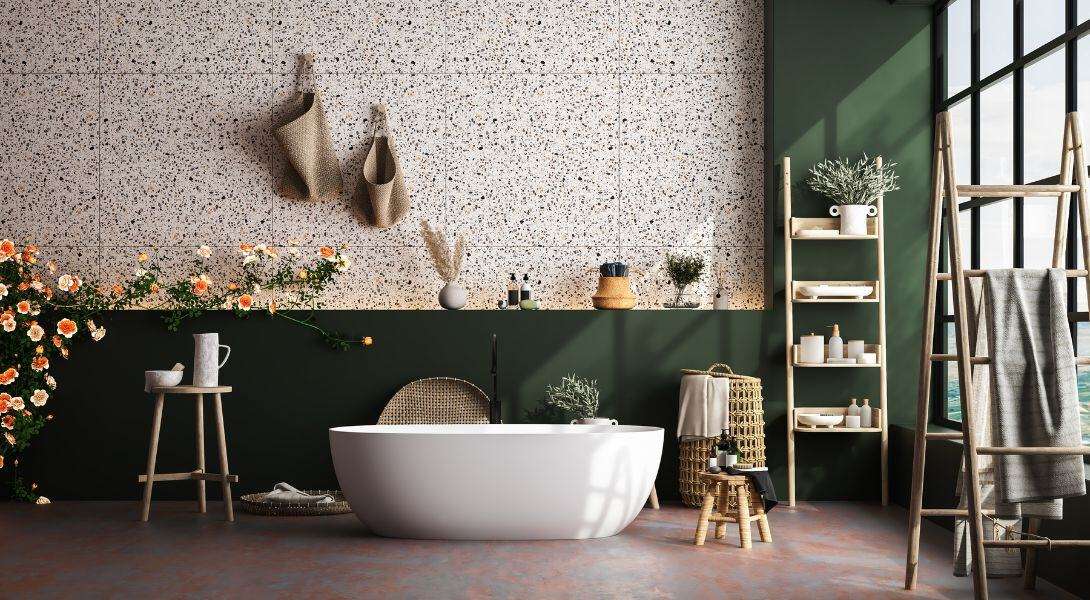Interior Design Materials: How to Use Timber, Concrete, Marble & More
Updated:
Published:
Approximate Reading Time: 6 Minutes
When people ask us about home renovations and interior designs, it's always about colours, furniture and, of course, our excellent flooring and how it all ties into a space.
I get it; colours are bold and vibrant and, alongside furniture choices, can often act as a way to represent your own personal style in a space.
However, what they should have been asking about was how to choose the right materials.
Understanding how to choose and use different materials is key to bringing depth and visual interest to a space and elevating the conversation beyond a simple, "Wow, that's a nice feature wall."
For interior design tips on how to use colour for your next project, read our latest article "How to Use Bold Colours In Interior Design: Tips for 2025 Trends"

How to Choose the Right Materials
Your choice of materials shapes the mood, defines a space and creates depth. The best interiors have a material palette that is entirely intentional and works to tie all the elements of a room together; without it, a room can feel off.
I find that often, it helps to start with the architecture of the space you are designing-is it contemporary, industrial, bohemian?
From there, it's just about understanding your options and selecting the right one.

Ceramic
Ceramic is an incredibly versatile material made from natural clay that is shaped and fired at high temperatures. Available in various finishes such as glossy, matte or textured.
Durable and adaptable, ceramic is popular as hand-painted and pattered decor that can add a unique, refined finish to any space.
Where it is used:
- Bathroom: Walls, floors and sink basins
- Living Room: Decorative vases, lamps and side tables
- Kitchen: Backsplashes and floors
- Design Styles: Minimalistic, Scandinavian, Mid-Century Modern

Concrete
Concrete is a robust industrial material made from cement and water. Its raw form is used for a rustic, urban look that is popular in modern and industrial designs.
Concrete can also be polished for a sleeker finish and a more luxurious feel that pairs well with natural timbers and soft fabric.
Where it is used:
- Kitchen: Concrete countertops and kitchen islands
- Bathroom: Vanities, shower walls, floors
- Living room: Floor, fireplace
- Outdoor: Outdoor kitchen, seating, planters
- Design Styles: Industrial, Minimalist, Mid-Century Modern

Terrazzo
Terrazzo is a composite material made from embedding pieces of marble, quartz, granite or glass into a cement or resin base. Popular for its sparkly, artistic patterns, terrazzo is perfect as a statement material.
It can be customised to taste with different colours, textures and chip sizes, making it both functional and decorative.
Where it is used:
- Bathroom: Shower walls, vanity tops, floors
- Kitchen: Floors, countertop
- Living Room: Accent pieces, trays, tabletops
- Design Styles: Art Deco, Bohemian, Contemporary

Marble
Marble is a timeless natural stone material known for its smooth finish and unique and striking veining patterns. The epitome of luxury marble is a staple in interior design.
Available in a variety of colours, marble can easily fit into most designs and has a timeless appeal known for its elegance and sophistication.
Where it is used:
- Kitchen: Countertops, backsplashes, kitchen islands
- Bathroom: Walls, floors and vanities
- Living Room: Coffee table, fireplace, side tables
- Design Styles: Contemporary, Art Deco, Parisian

Granite
Granite is a naturally occurring material known for its speckled appearance and durability. Generally seen as a more traditional material, honed or leathered graphite can still feel incredibly modern.
Its high resistance to stains, heat, and scratches makes it a practical choice for busy households. It is available in a wide variety of patterns and colours.
Where it is used:
- Kitchen: Countertop, backsplashes
- Bathroom: Vanity tops, shower walls
- Living Room: Fireplaces, coffee tables
- Design Styles: Minimalist, Scandinavian, Japandi

Quartz
Quartz is an engineered material that combines quartz crystals and pigments to mimic the appearance of natural stone. This ability, along with its clean aesthetic, makes it a popular pick for homeowners.
Its durability, low maintenance, and lower cost compared to more luxurious materials like marble make it a practical choice for any home.
Where is it used:
- Kitchen: Countertops, benchtops and kitchen islands
- Bathroom: Vanities, shower walls and backsplashes
- Living Room: Coffee table and fireplaces
- Design Styles: Japandi, Contemporary, Minimalist

Copper
Copper is a warm-toned metal of reddish-orange hue. It is highly malleable and used for structural elements, ornamentation and decorative accents.
Known for bringing a sense of warmth and drama, it is adaptable to many design styles and can create a rich contrast with materials like timber or stone.
Where it is used:
- Kitchen: Sinks, taps, cookware
- Bathroom: Faucets, light fixtures, bathtubs
- Living Room: Light fixtures, tables, furniture ornamentation
- Design Styles: Industrial, Art Deco, Mid-Century Modern

Leather and Faux Leather
Made from animal hides, leather is often associated with luxury and quality, with faux leather being an affordable and ethical artificial option replicating the same look and feel.
Able to be dyed, tufted or panelled, it can come in various colours and forms, making it a versatile choice.
Where it is used:
- Living Room: Sofas, ottomans, armchairs
- Bedroom: Bed headboards, foot-side benches
- Dining Room: Dining chairs, stools
- Design Styles: Mid-Century Modern, Parisian, Industrial
Love the look? Get a Free Measure and Quote!
Timber
Timber is a timeless material that offers a variety of appearances based on its finishing and species of tree. Used in fluting or inlays, it can elevate any space.
The colour, style, and unique intricate details in its veining can add authenticity and character through furniture, panelling, or flooring.
Where it is used:
- Dining Room: Table centrepiece and dining chairs
- Living Room: Coffee table, shelves, TV console
- Bedroom: Headboard and side tables
- Design Styles: Scandinavian, Contemporary, Japandi
Click here to explore our range of timber flooring!
Laminate
Laminate flooring is a versatile and budget-friendly option that replicates the look of natural timber or stone. Made up of multiple layers fused together through a lamination process, it’s durable, scratch-resistant, and easy to maintain, making it a popular choice for Aussie homes.
Its an affordable alternative to hardwood, easy to maintain and install and available in a wide range of designs and finishes making it adaptable to any style.
Where it’s used:
- Living Room: Perfect for high-traffic areas thanks to its durability.
- Bedroom: Adds warmth and comfort underfoot.
- Kitchen: Resistant to spills and stains, making it practical for busy households.
- Home Office: Gives a polished, professional look without breaking the bank.
- Design Styles: Contemporary, Traditional
Click here to explore our range of Laminate flooring.
Vinyl
Vinyl flooring is a resilient and comfortable option that’s perfect for areas prone to moisture. Available in sheets, tiles, or planks, it can mimic the look of timber, stone, or even tiles. Its water-resistant properties make it a standout choice for wet areas like bathrooms and kitchens.
Soft to walk on and easy to install and replace it is a practical choice for any home.
Where it’s used:
- Bathroom: Waterproof and slip-resistant, ideal for wet areas.
- Kitchen: Durable and easy to clean, perfect for busy cooks.
- Laundry: Handles moisture and spills with ease.
- Commercial Spaces: Tough enough to handle heavy foot traffic.
- Design Styles: Industrial, Bohemian, Rustic:
Carpet
Carpet is all about comfort, warmth, and sound insulation. It’s available in a variety of fibres, patterns, and pile heights, making it a versatile choice for creating cosy, inviting spaces.
Able to provide insulation against the cold and noise, whether you’re after plush luxury or hard-wearing practicality, there’s a carpet to suit every home.
Where it’s used:
- Bedroom: Soft and warm underfoot, perfect for creating a relaxing retreat.
- Living room: Adds texture and warmth to seating areas.
- Nursery: Safe and comfortable for little ones to play on.
- Design Styles: Traditional, Modern, Eclectic
Click here to explore our range of carpets.
Need help choosing the right flooring? Book a Free consultation!
How to Mix Materials Together in Design

Mixing materials together is what gives a space a feeling of depth and personality. It's all about finding the right balance between contrast and cohesion, as too many elements at once can cause a space to feel chaotic and messy.
There is really so much that could be mentioned that could be an article all of itself, but some general considerations are:
- Balancing between contrast and cohesion
- Layering textures together for depth
- Mixing natural and industrial elements
- Mixing with matte and glossy finishes
- Using flooring as the base of your material palette
- Stick to a consistent colour palette to keep things harmonious
- Mix textures, like smooth vinyl with plush carpet to add depth and dimension
- Use transition strips to seamless connect different flooring types
Some specific examples include:
- Pairing smooth polished quartz or marble with raw concrete for a balanced, sleek, and industrial look
- Pairing marble or terrazzo statement pieces with softer materials like wood or fabric
- Pairing warm metals like copper with cool neutrals like granite to create a harmonious aesthetic
- Pairing terrazzo and quartz for a play yet elegant colour palette
- Pairing granite with timber for an earth-organic feel
- Pairing ceramic with metal accents such as copper adds warmth and detail
- Pairing laminate in the living room with carpet in the bedroom for a balanced, functional feel
- Pairing vinyl in the kitchen and bathroom for practicality and to tie the rooms together
Choosing Materials for Your Next Project
The best interiors blend together materials to create depth, visual interest and contrast to keep a space from feeling too simple or one-dimensional. Materials should be chosen not just for their look but for how they feel, function and interact with elements in a space.
Have any questions? Chat with our Flooring experts! Find your nearest Floorworld store.
For more interior design tips about colour, materials, styles and trends, check out our latest eBook "Step into 2025 with Style: Mastering the Art of Interior Design"



